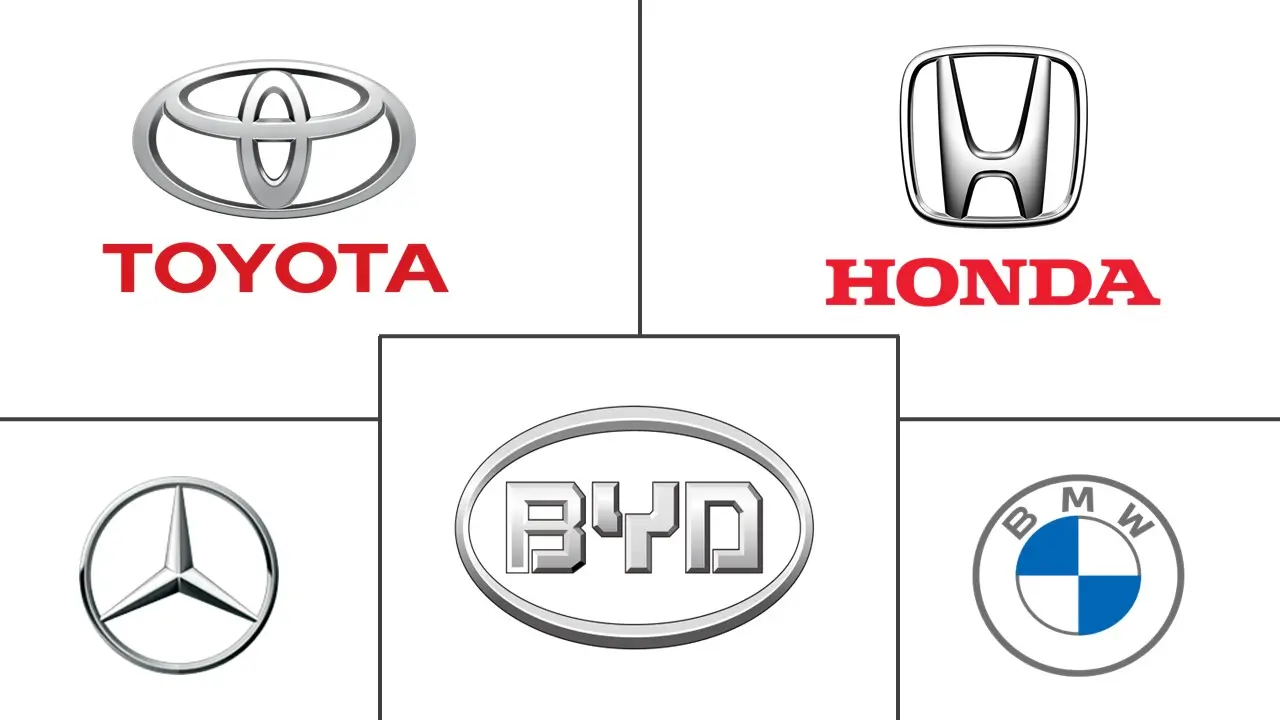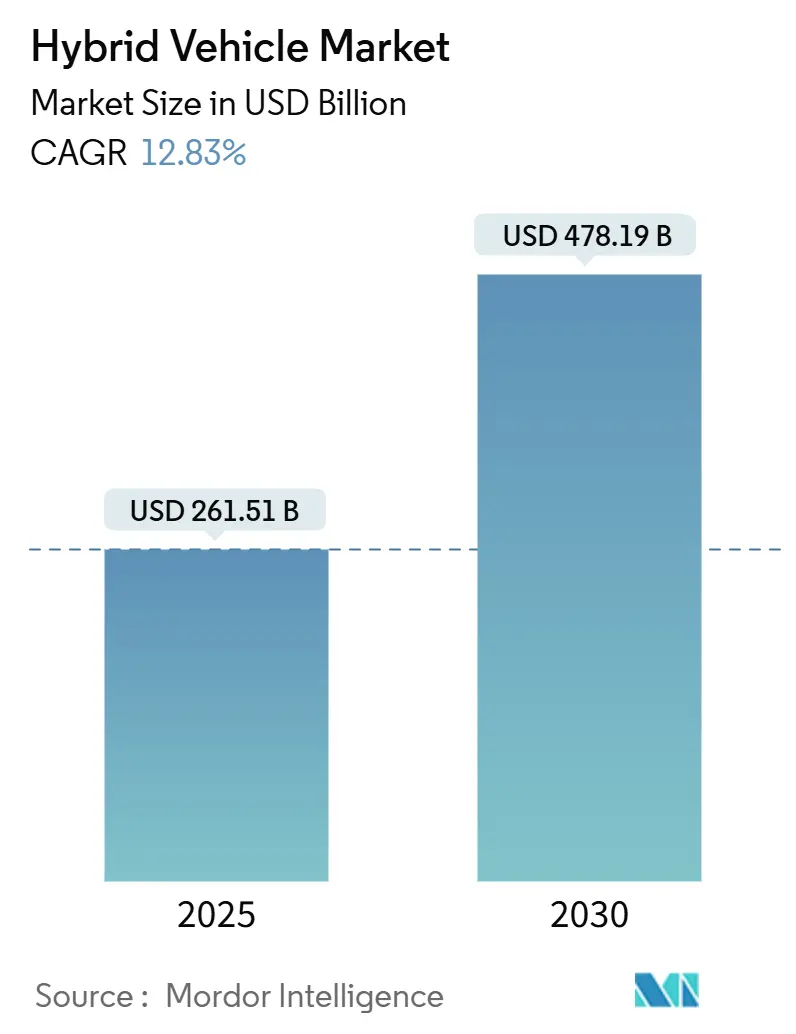
Hybrid Vehicle Market Analysis by Mordor Intelligence
The hybrid vehicle market size holds a value of USD 261.51 billion in 2025 and is forecast to reach USD 478.19 billion by 2030, advancing at 12.83% CAGR. Rapid electrification policies, falling battery prices, and consumer determination to hedge against fuel volatility keep demand resilient across every major region. Automakers treat hybrids as profit engines that bankroll the scale-up of battery plants, while policymakers accept them as a practical compliance tool for tougher greenhouse-gas limits. Competitive intensity is escalating as Japanese incumbents fortify their lead, Chinese brands widen global reach, and Western OEMs re-enter the fray with new multi-pathway plans. Infrastructure disparities, regulatory convergence, and portfolio risk management together ensure the hybrid vehicle market remains strategically relevant for the next decade.
Key Report Takeaways
- By propulsion type, hybrid electric vehicles led with 43.81% of the hybrid vehicle market share in 2024; plug-in hybrids are positioned to expand at a 13.82% CAGR to 2030.
- By vehicle type, passenger cars accounted for 78.04% of the hybrid vehicle market size in 2024, while light commercial vehicles are forecast to grow at 15.23% CAGR through 2030.
- By motor type, permanent-magnet synchronous motors commanded a 62.15% share of the hybrid vehicle market size in 2024; induction motors record the highest projected CAGR at 12.95% to 2030.
- By battery type, lithium-iron-phosphate packs captured 45.66% revenue share in 2024 and are advancing at a 15.56% CAGR through 2030.
- By geography, Asia-Pacific led with 41.24% hybrid vehicle market share in 2024; Europe is on track for the fastest 14.95% CAGR during 2025-2030.
Global Hybrid Vehicle Market Trends and Insights
Drivers Impact Analysis
| Driver | (~) % Impact on CAGR Forecast | Geographic Relevance | Impact Timeline |
|---|---|---|---|
| Stricter Global CAFE/GHG Norms & Zero-Emission Mandates | +3.2% | North America & EU, global spill-over | Medium term (2-4 years) |
| Battery Cost-parity Tipping Point for PHEVs by 2027 | +2.8% | China & Europe, global influence | Medium term (2-4 years) |
| Soaring Fuel-price Volatility Post-2024 | +2.1% | Emerging markets & mature economies alike | Short term (≤ 2 years) |
| OEM Multi-pathway Carbon Strategies (ICE + BEV + HEV) | +1.9% | Led by Japan & Europe, adopted worldwide | Long term (≥ 4 years) |
| 48 V Architecture Standardization in Light Trucks | +1.4% | North America & Europe, expanding to APAC | Medium term (2-4 years) |
| Grid-independent Emergency-Power Use Case in Disaster-prone Regions | +0.8% | APAC core, global disaster-prone regions | Long term (≥ 4 years) |
| Source: Mordor Intelligence | |||
Stricter Global CAFE/GHG Norms & Zero-Emission Mandates
Fleetwide emissions ceilings in the United States and the European Union synchronize around the 2030 horizon, compelling automakers to employ hybrids to avoid penalties. The US Environmental Protection Agency sets targets of 85 g CO₂ / mile for 2032, while Euro 7 introduces battery-durability rules that strongly favor mature hybrid chemistries. Automakers exploit the compliance flexibility inherent in hybrids to smooth the transition to full electrification, thereby safeguarding capital budgets earmarked for gigafactories. Similar policy architecture appears in Australia and China, creating a coherent regulatory scaffolding that lifts the global hybrid vehicle market.
Battery Cost-Parity Tipping Point for PHEVs by 2027
Lithium-ion pack prices slide toward USD 100 /kWh, narrowing the cost delta between plug-in hybrids and conventional models. CATL’s 2024 Freevoy module delivers 4C charging and over 400 km electric-only range, slashing perceived compromises that once capped PHEV demand. Analysts at the International Council on Clean Transportation expect sub-USD 80 /kWh by 2030, anchoring a renewed value proposition that accelerates PHEV adoption, especially in China and Europe.
Soaring Fuel-Price Volatility Post-2024
The post-pandemic energy cycle pushes gasoline prices to record highs in many economies, prompting cost-sensitive buyers to choose hybrids that cut fuel use without relying on public chargers. US Department of Energy data show hybrid sales climbing 53% in 2023 as pump prices spiked, while emerging-market consumers doubled down on hybrids where grid upgrades are lagging. As fuel subsidies unwind, households treat hybrids as insurance against future price shocks, which sustains momentum in the hybrid vehicle market [1]“Hybrid Electric Vehicle Sales Data 2023,” US Department of Energy, energy.gov.
OEM Multi-Pathway Carbon Strategies
Major manufacturers refine diversified roadmaps that hedge technology risk across internal-combustion, hybrid, and battery-electric platforms. Toyota pledges a hybrid-only lineup for core models beginning with the 2026 RAV4, while Ford publicly commits to extending hybrid availability well into the 2030s. Secure mineral supply chains and joint-venture battery plants complement the strategy, ensuring hybrids fund the shift toward full electrification without breaching near-term margin targets. This holistic portfolio logic underpins the long-run expansion of the hybrid vehicle market [2]“Global EV Outlook 2025,” International Energy Agency, iea.org.
Restraints Impact Analysis
| Restraint | (~) % Impact on CAGR Forecast | Geographic Relevance | Impact Timeline |
|---|---|---|---|
| BEV Total-Cost-of-Ownership Parity Achieved in Urban Fleets | −2.4% | North America & EU city hubs | Medium term (2-4 years) |
| Scarcity of Sustainably Mined Nickel & Cobalt | −1.8% | Global battery supply chains | Long term (≥ 4 years) |
| Consumer Range-anxiety Bias Shifting Straight to BEV | −1.1% | Developed markets with mature charging | Short term (≤ 2 years) |
| Looming End-of-Life Recycling Liabilities for NiMH Packs | −0.7% | Japan & mature hybrid markets | Long term (≥ 4 years) |
| Source: Mordor Intelligence | |||
BEV Total-Cost-of-Ownership Parity Achieved in Urban Fleets
Depot charging, low electricity tariffs, and city toll exemptions allow battery-electric vans and taxis to undercut hybrid operating costs in dense corridors. Studies by Transport & Environment find medium BEVs 14% cheaper than diesel equivalents on a lifetime basis in Paris. As municipal infrastructure matures, fleet buyers may bypass hybrids in favor of zero-tailpipe solutions, trimming incremental growth in the hybrid vehicle market [3]“Electric Vehicle Total Cost of Ownership,” Transport & Environment, transportenvironment.org .
Scarcity of Sustainably Mined Nickel & Cobalt
Nickel demand for clean-tech applications could rise 10-fold by 2040, and cobalt faces similar supply-demand tension. Sustainability audits and traceability requirements further tighten the usable supply. Price spikes feed through to battery modules, compressing margins for hybrid offerings that still contain sizeable packs. Although recycling may ease long-term pressure, short- and medium-term scarcity poses a material headwind to hybrid vehicle market expansion.
Segment Analysis
By Propulsion Vehicle Type: PHEVs Drive Electrification Transition
Hybrid electric vehicle account for 43.81% of the hybrid vehicle market, anchoring volume for mainstream passenger cars in 2025. Steady cost advantages and proven reliability keep demand resilient even as infrastructure improves. OEMs refine series-parallel architectures and downsize internal-combustion engines to maximize compliance credits. In contrast, plug-in hybrids record a 13.82% CAGR, closing the gap as buyers value electric-only commuting. Cost-parity milestones forecast for 2027 push PHEVs into wider price bands, broadening shopper appeal.
The hybrid electric vehicle market is likely to see plug-in variants challenge hybrid electric vehicle primacy after 2028 as energy-density gains permit sub-USD 25,000 sticker prices. CATL’s Freevoy pack allows 10-minute top-ups that unlock 280 km of range, neutralizing range anxiety and underpinning the segment surge. Policy sweeteners such as China’s tax credits and Europe’s benefit-in-kind relief further tilt fleets toward PHEVs, ensuring technology coexistence rather than rapid displacement.
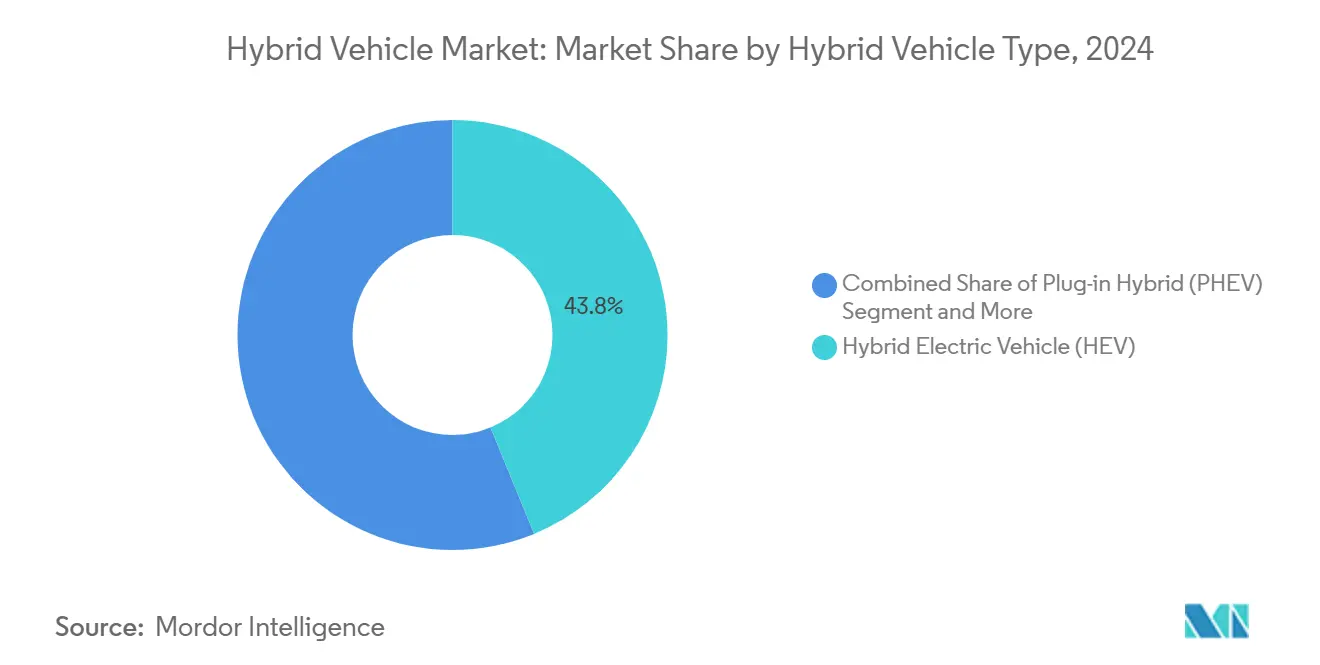
Note: Segment shares of all individual segments available upon report purchase
By Vehicle Type: Commercial Fleets Accelerate Electrification
Passenger cars remain the bedrock of the hybrid vehicle market, controlling 78.04% revenue in 2024. High registration taxes on conventional engines in Europe and Japan funnel buyers into hybrids, while US consumers gravitate to fuel-efficient crossovers such as the hybrid-only 2025 Camry. OEM marketing stresses minimal lifestyle changes and quick payback, sustaining penetration in the world’s largest light-vehicle segments.
Light commercial vehicles grow at 15.23% CAGR through 2030 as parcel-delivery, municipal, and trades fleets search for cost-effective decarbonization. Volkswagen’s Multivan eHybrid and Ford’s E-Transit Custom Hybrid illustrate how OEMs tailor battery size, payload, and charging flexibility for fleet duty cycles. The hybrid vehicle industry benefits from corporate ESG targets that require tangible emissions cuts before public charging networks fully saturate suburban and rural routes.
By Motor Type: PMSM Efficiency Drives Market Leadership
Permanent-magnet synchronous machines deliver best-in-class torque density, securing 62.15% share of the hybrid vehicle market size in 2024. High copper fill factors and superior part-load efficiency improve combined-cycle fuel economy, letting automakers downsize batteries without sacrificing performance. Yet reliance on rare-earth materials invites cost volatility.
Induction motors will expand at 12.95% CAGR, propelled by patent-free designs and robust heat tolerance. GM’s latest stator-winding pattern reduces rotor losses, narrowing the real-world efficiency gap versus PMSM to low single digits. As copper prices stabilize and silicon-carbide inverters mature, induction machines gain favor in price-led models aimed at emerging markets, diversifying motor supply chains inside the hybrid vehicle market.
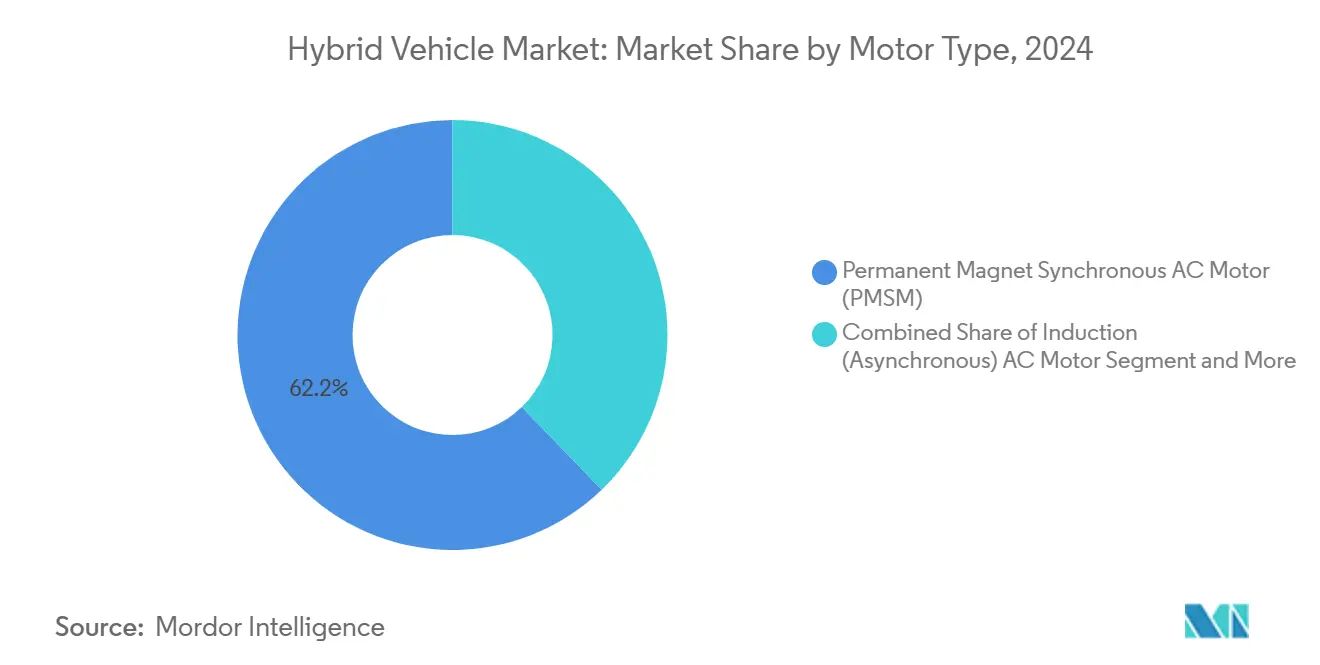
Note: Segment shares of all individual segments available upon report purchase
By Battery Type: LiFePO4 Dominance Reflects Safety Priorities
Lithium-iron-phosphate chemistry controls 45.66% of the hybrid vehicle market size in 2024, and it also posts the fastest 15.56% CAGR through 2030. OEMs value inherent thermal runaway resistance that satisfies incoming Euro 7 battery durability rules without expensive cooling. Tesla, BYD, and Ford deploy LFP packs in cost-sensitive trims, validating chemistry at a global scale and encouraging suppliers to expand cathode capacity. The upshot is falling module prices that reinforce the hybrid vehicle market’s ability to undercut BEV sticker prices in price-elastic segments.
Nickel-metal-hydride remains entrenched in legacy Toyota and Honda hybrids thanks to proven reliability and robust recycling take-back loops. Regenerated NiMH cells achieve 80-85% of original capacity and slash end-of-life emissions, offering a circular-economy advantage that keeps the chemistry relevant where extreme energy density is non-critical. Premium hybrids adopt high-nickel NCM or NCA cathodes to unlock sportier performance, delivering a tiered battery landscape that aligns with trim-level differentiation strategies across the hybrid vehicle market.
Geography Analysis
Asia-Pacific retains 41.24% of the hybrid vehicle market share in 2024 on the back of deep domestic supply chains, powerful policy support, and vibrant consumer demand. China accounts for most regional volume after plug-in hybrid registrations soared more than 80% annually between 2022 and 2024. BYD alone shifted nearly 2.5 million hybrids in 2024, scaling local battery plants that lower costs across ASEAN export programs. Japanese OEMs maintain hefty volumes at home and accelerate hybrid exports to Oceania, reinforcing a virtuous production loop that protects margins.
Europe is the fastest-growing geography with a projected 14.95% CAGR to 2030. The region’s fuel-economy penalties, congestion charges, and company-car tax reliefs propel hybrid adoption even as BEV incentives taper. Italy’s new-car mix hit 40% hybrids in 2024, and France passed 2 million rechargeable vehicles. Germany and the United Kingdom posted record electric-mobility shares, yet consumers still migrate to hybrids for long-distance convenience. Supply lines from Poland, Slovakia, and Spain attract fresh battery-module investment, shortening logistics for European assembly plants and sustaining downward cost curves that strengthen the hybrid vehicle market.
North America shows divergent provincial and state incentives, but national hybrid penetration climbed to 12.1% of light-vehicle sales in 2024. Regulatory certainty through the EPA’s 2032 rule set catalyses broader model coverage across pickups and SUVs, while gasoline price spikes during 2024 cement mainstream acceptance. Emerging markets in South America, the Middle East and Africa rely on hybrids to leapfrog charging-infrastructure bottlenecks. Government fleets pilot hybrid buses and patrol vehicles, demonstrating use-case viability and paving the way for commercial uptake that enlarges the global hybrid vehicle market.
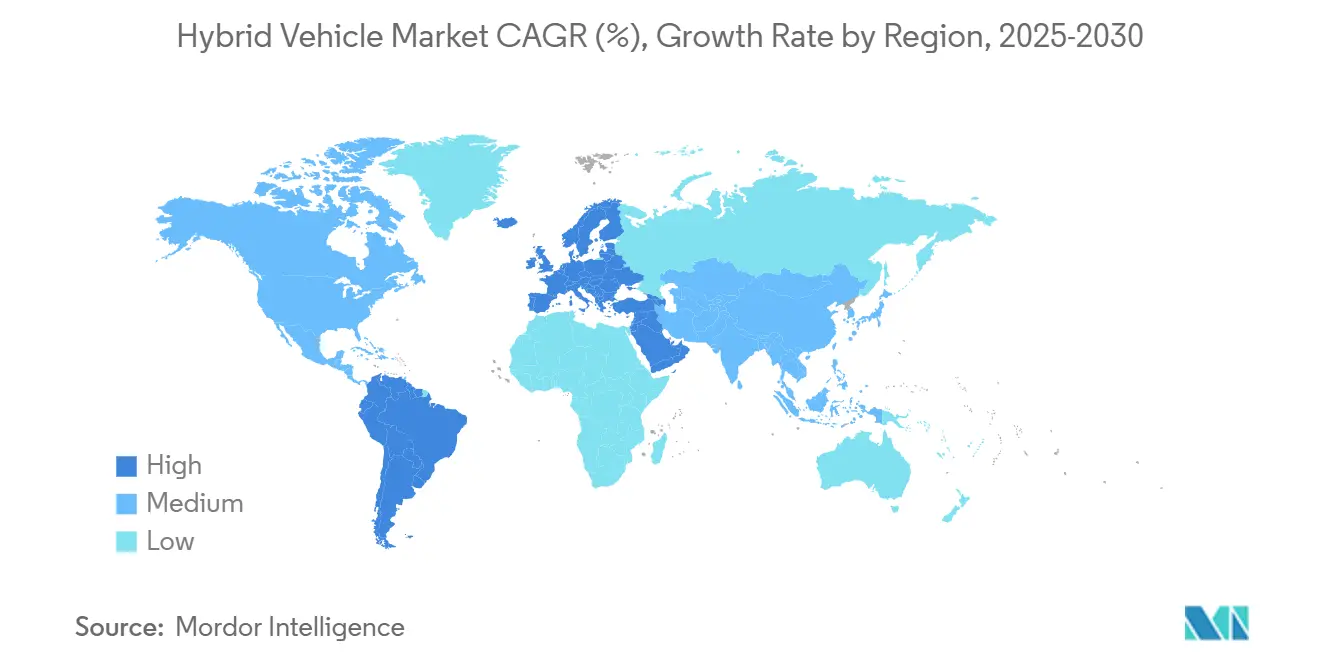
Competitive Landscape
The global hybrid vehicle market exhibits moderate concentration with intensifying competition as traditional automotive manufacturers leverage hybrid profitability to finance electric-vehicle development while new entrants challenge established positions. Japanese automakers maintain strategic advantages through decades of hybrid know-how, and Chinese manufacturers are rapidly gaining ground through aggressive plug-in-hybrid strategies. Strategic differentiation increasingly centers on battery technology integration and multi-pathway portfolios rather than pure hybrid system development.
Chinese challengers transform the landscape by exporting cost-competitive plug-in hybrids into Europe, Southeast Asia, and Latin America. BYD’s DM-i technology undercuts rivals on both price and electric-only range, while SAIC Motor leverages joint ventures with MG to rebuild dormant European brands using hybrid drivelines. European and US OEMs pivot back to hybrids after overcommitting to BEVs. General Motors patents a multi-mode hybrid architecture that can retrofit existing truck platforms, and Ford augments Maverick and F-150 line-ups with 2.5-liter Atkinson-cycle hybrids, proof that profit pools shift again toward diversified power-train portfolios inside the hybrid vehicle market.
Strategic actions focus on upstream materials and downstream software. Stellantis signs multi-year nickel contracts with Indonesian producers, Volkswagen takes a minority stake in QuantumScape for solid-state R&D and Hyundai deploys over-the-air updates that refine hybrid energy-management algorithms. Partnerships proliferate: Renault’s Horse Powertrain supplies turnkey hybrid modules to third-party brands, while Bosch teams with Mahle on cost-optimized 48 V modules for commercial vans. Competitive boundaries blur as suppliers bundle motors, inverters and control software as platform services, intensifying the fight for share and reinforcing consolidation trends already visible in the hybrid vehicle market.
Hybrid Vehicle Industry Leaders
-
Toyota Motor Corporation
-
BMW AG
-
Mercedes-Benz Group AG
-
Honda Motor Co., Ltd.
-
BYD Co., Ltd.
- *Disclaimer: Major Players sorted in no particular order

Recent Industry Developments
- June 2025: General Motors confirms new Chevrolet hybrids for the 2026 model year to balance its EV roadmap while satisfying stricter US emission rules.
- May 2025: Toyota states the 2026 RAV4 will be sold exclusively as a hybrid, echoing the 2025 hybrid-only Camry strategy.
- April 2025: Horse Powertrain debuts a compact, fully integrated hybrid module at Auto Shanghai 2025, offering OEMs a drop-in alternative for existing EV platforms.
Research Methodology Framework and Report Scope
Market Definitions and Key Coverage
Our study defines the hybrid vehicle market as every new on-road passenger car and commercial vehicle that pairs an internal-combustion engine with an electric traction system able to propel the wheels; micro, mild, full, and plug-in hybrids shipped through OEM channels are counted at manufacturer selling price, net of incentives and taxes.
Scope Exclusion. We leave out retrofit kits, off-highway machinery, and pure battery-electric or fuel-cell models.
Segmentation Overview
- By Hybrid Vehicle Type
- Mild-Hybrid
- Hybrid Electric Vehicle (HEV)
- Plug-in Hybrid (PHEV)
- By Vehicle Type
- Passenger Cars
- Light Commercial Vehicles
- Medium and Heavy Commercial Vehicles
- By Motor Type
- Permanent Magnet Synchronous AC Motor (PMSM)
- Induction (Asynchronous) AC Motor
- Switched Reluctance Motor (SRM)
- Axial-Flux Motor
- By Battery Type
- Nickel-Metal Hydride
- Lithium-iron Phosphate Battery
- Other Battery
- By Geography
- North America
- United States
- Canada
- Rest of North America
- South America
- Brazil
- Argentina
- Rest of South America
- Europe
- Germany
- United Kingdom
- France
- Italy
- Norway
- Netherlands
- Rest of Europe
- Asia-Pacific
- China
- Japan
- India
- South Korea
- Rest of Asia-Pacific
- Middle East and Africa
- United Arab Emirates
- Saudi Arabia
- South Africa
- Turkey
- Egypt
- Rest of Middle East and Africa
- North America
Detailed Research Methodology and Data Validation
Primary Research
We spoke with power-train engineers, tier-one component suppliers, fleet buyers, and policy officials across Asia-Pacific, Europe, and North America. Their insights let us fine-tune battery cost curves, hybrid take-rates, and real-world price dispersion, confirming early desk findings and highlighting regional nuances.
Desk Research
We began by mapping supply and demand signals from open datasets such as OICA production logs, IEA alternative-fuel statistics, Eurostat registration files, and UN Comtrade HS-8703 trade flows. We then matched them with policy texts from US EPA CAFE rules, EU fleet CO2 targets, and JAMA roadmaps. Corporate 10-Ks, investor decks, and reputable press helped us shape average selling prices. Paid portals, including D&B Hoovers for company financials and Marklines for model-level launches, added depth. These references illustrate, not exhaust, the wider pool we reviewed to cross-check and clarify figures.
Additional desk work covered customs data, patent filings, and country fuel-price trackers, so we could ground our assumptions in verifiable public evidence before moving to primary validation. Many further sources were screened to close residual gaps.
Market-Sizing & Forecasting
Our top-down model starts with country production plus imports, applies verified hybrid penetration by propulsion class to derive unit pools, and then multiplies by sampled OEM price lists to estimate revenue. Parallel bottom-up checks, such as selected supplier roll-ups, keep totals anchored. Key variables tracked include 48 V adoption, lithium-ion $/kWh trends, CAFE step-ups, retail fuel prices, and OEM launch pipelines. A multivariate regression, supported by expert consensus, projects demand through 2030, with scenario analysis where policy shocks loom.
Data Validation & Update Cycle
Outputs face peer reviews, variance checks against shipment trackers, and reconciliation with macro drivers. Models refresh every twelve months, with interim revisions if material events occur. Before release, an analyst reruns the latest data import so clients receive the most current view.
Why Mordor's Hybrid Car Baseline Earns Decision-Maker Trust
Published figures differ because firms group technologies differently, treat incentives in their own way, and refresh at unequal intervals.
Key gap drivers we observe are whether 12 V mild systems are included, how fleet rebates are netted, the timing of currency conversion, and the speed at which battery-cost assumptions are updated. Mordor's scope mirrors regulatory definitions, and our annual refresh captures rapidly shifting cost curves, keeping our totals aligned with market reality.
Benchmark comparison
| Market Size | Anonymized source | Primary gap driver |
|---|---|---|
| USD 261.51 B (2025) | Mordor Intelligence | |
| USD 312.80 B (2025) | Global Consultancy A | Counts only passenger cars yet applies global average ASP, inflating value |
| USD 291.42 B (2024) | Industry Publisher B | Uses fixed 2022 exchange rates and excludes OEM rebates, lifting topline |
| USD 568.93 B (2024) | Data Aggregator C | Adds hybrid component revenue and retrofit kits to vehicle sales |
The comparison shows that scope, pricing treatment, and refresh cadence can swing totals widely; Mordor's disciplined variable selection and transparent steps deliver a balanced, repeatable baseline our clients can rely on.
Key Questions Answered in the Report
What is the current size of the hybrid vehicle market?
The market is valued at USD 261.51 billion in 2025 and is projected to reach USD 478.19 billion by 2030.
Which region leads the hybrid vehicle market?
Asia-Pacific holds 41.24% of global share, driven by strong demand in China and Japan.
Which hybrid segment is growing fastest?
Plug-in hybrid electric vehicles post the highest 13.82% CAGR through 2030 due to battery cost declines and longer electric ranges.
Why are automakers still investing in hybrids instead of going fully electric?
Hybrids generate near-term profits, help meet tightening emission targets and provide a hedge while charging infrastructure scales.
Page last updated on:
